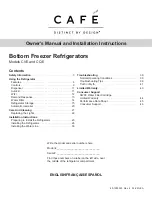
Nettoyage
L’appareil étant convenablement installé, nous vous
conseillons de le nettoyer soigneusement avec de
l’eau tiède savonneuse, pour enlever l’odeur
caractéristique de «neuf».
N’utilisez pas de produits abrasifs, de
poudre à récurer ni d’éponge métallique.
UTILISATION DU CONGELATEUR
Le congélateur est repéré par le symbole
ce qui signifie qu’il est apte à la congélation de
denrées fraîches, au stockage de produits
surgelés et à la fabrication de cubes de glace.
Mise en service
Enfoncez la fiche dans la prise de courant (le voyant
(D) s’ allume en indiquant que l’appareil est sous
tension).
Tournez le bouton du thermostat (E) vers la droite
sur une position moyenne.
Le voyant (A) s’allume.
Pour arrêter l’appareil tournez le bouton du
thermostat sur la position «
■
».
Réglage de la température
La température est réglée automatiquement et peut
être augmentée (moine froid) en tournant le bouton
vers le minimum ou bien diminuée (plus froid) en le
tournant vers le maximum.
En tout cas, l’exacte position doit être repérée en
considérant que la température interne dépend des
facteurs suivants:
•
température ambiante;
•
fréquence d’ouverture des portes;
•
quantité d’aliments conservés;
•
emplacement de l’appareil.
Une position moyenne est la plus indiquée.
Important
Si le thermostat est réglé sur la position de froid
maximum, lorsque la température ambiante est
élevée et que l'appareil est plein, il est possible
que le compresseur fonctionne en régime
continu. Dans ce cas, il y a un risque de
formation excessive de givre sur la paroi
postérieure à l’intérieur de l’appareil. Pour éviter
cet inconvénient, placez le thermostat sur une
position moins élevée, de façon à permettre un
dégivrage automatique et, par conséquent, des
économies de courant.
Congélation rapide
Pour la mise en congélation rapide appuyer sur le
bouton (B).
Le voyant (C) s’allume.
UTILISATION
Tableau de commande
min
max
A
B C D
E
ON
SUPER
ALARM
min
max
ON
F
G
A.
Voyant d’alarme
B.
Bouton de conservation / mise en congélation
rapide (Normal/Super)
C.
Voyant de mise en congélation rapide
D.
Voyant de fonctionnement du congélateur
E.
Bouton du thermostat du congélateur
F.
Voyant de fonctionnement du réfrigérateur
G
Bouton du thermostat du réfrigérateur
16
33
Rear spacers
In the bag with the documentation, there are two
spacers which must be fitted as shown in the
figure.
Slacken the screws and insert the spacer under the
screw head, then re-tighten the screws.
D594
Changing the opening direction of
the doors
Before carrying out any operations, remove the plug
from the power socket.
To change the opening direction of the door,
proceed as follows:
1. pull off the ventilation grille (D) which is clipped
into place;
2. remove the bottom hinge (E) by unscrewing its
fixing screws;
3. remove the lower door, sliding it out of the middle
hinge;
4. unscrew the middle hinge (H);
5. remove the upper door, releasing it from the
upper pin (G);
6. unscrew the upper pin (G) and refit it on the
opposite side;
7. remove the two plugs of the door (where
available), discovering the holes for the hinge
pins, assemble them on the opposite side and
refit the upper door;
8. reassemble the middle hinge on the opposite
side;
9. reassemble the lower door;
10.using a 10 mm spanner, unscrew the hinge pin
(E) and reassemble it on the opposite side of the
hinge;
11. reassemble the lower hinge (E) on the opposite
side, using the screws previously removed. Slide
the hole cover (F) out of the ventilation grille (D)
by pushing it in the direction of the arrow and
reassemble it on the opposite side;
12. refit the ventilation grille (D), clipping it into
place.
13.Dismantle the handles and reassemble them on
the opposite side. Cover the holes left open with
the plugs contained in the documentation pack.
To line up the doors, it is possible to adjust the
middle hinge (H) horizontally by means of a tool,
after slackening the two screws (see figure).
Warning:
After having reversed the opening direction of
the doors check that all the screws are properly
tightened and that the magnetic seal adheres to
the cabinet.
If the ambient temperature is cold (i.e.
in Winter), the gasket may not fit perfectly to the
cabinet. In that case, wait for the natural fitting of the
gasket or accelerate this process by heating up the
part involved with a normal hairdrier.
G
H
F
F
D
F
F
E
E































